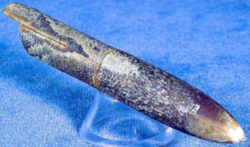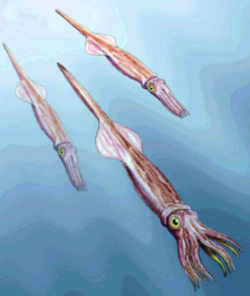Delaware State Fossil
Cretaceous Belemnite

(Belemnitella americana)
Adopted on July 2, 1996.
On July 2, 1996, Cretaceous Belemnite, (Belemnitella americana,) was named as the official fossil of Delaware. The Martin Luther King, Jr. Elementary School (Wilmington) third grade Quest students of Kathy Tidball suggested honoring the ancient and noble belemnite as our State fossil.
Delaware State Fossil: Cretaceous Belemnite

The belemnite was, in essence, a squid with a conical shell. It is an extinct member of the phylum Mollusca, which includes clams, snails, squids and octopuses. Belemnite fossils can be easily found along the Chesapeake and Delaware Canal, which is where the Quest Students collected specimens during a field trip.
Belemnite is the common name applied to an extinct order (Belemnoida) of mollusks belonging to the cephalopod class. Modern cephalopods include the squid, octopus, and pearly Nautilus. The belemnoid animal was most closely related to the squid as it had an internal shell covered by a leathery skin, tentacles that pointed forward, and a siphon that expelled water forward thus moving the animal backward by jet propulsion. The internal shell of the belemnoid was cone-shaped and divided into chambers that were gas-filled for maintaining buoyancy in the sea. The chambered shell had a blade-like forward extension that is seldom preserved as a fossil. The most common fossilized part of the internal shell is called the "guard" or "cigar" consisting of a massive, generally brown-colored, subcylindrical structure called the rostrum that encloses the chambered shell and extends to the rear where it tapers to a conical apex. The rostrum served as a counter-weight to the buoyancy provided by the chambered shell and also for protection of that delicate shell. Belemnoids reached their greatest abundance and diversity during the Jurassic and Cretaceous periods.
Belemnites have been found abundantly in the exposures of the Mount Laurel Formation along the banks of the Chesapeake and Delaware Canal in Delaware, east of St. Georges. The fine-grained sands and silts of the Mount Laurel were deposited in a shallow sea during the Late Cretaceous time around 70 million years ago. The fossil belemnite species found here is Belemnitella americana.
Sometimes, almost complete belemnite guards can be found, similar in size and shape to a pencil, pointed at one end, but flaring at the other end (if preserved) and partly hollow in the center where the chambered shell was located. Often, only rod-like broken sections of the brown rostrum are found.
Delaware Law
The law designating the belemnite as the official Delaware state fossil is found in the Delaware Code, Title 29 (State Government) Chapter 3 (STATE SEAL, SONG, AND SYMBOLS) Section 314.
TITLE 29 - State Government.
PART 1 - General Provisions.
CHAPTER 3. STATE SEAL, SONG, AND SYMBOLS.
"§ 314. State fossil.
The official State fossil is the belemnite."
Approved July 2, 1996
Taxonomic Hierarchy: Belemnite
Kingdom: Animalia (animals)
Phylum: Mollusca
Class: Cephalopoda
Order: Belemnitida
Family: Belemnitellidae
Genus: Belemnitella
Species: Belemnitella americana

Some states that lack a "state fossil" have nevertheless singled out a fossil for formal designation such as a state dinosaur, rock, gem or stone.







